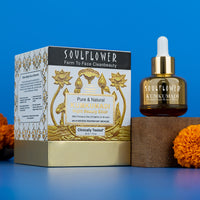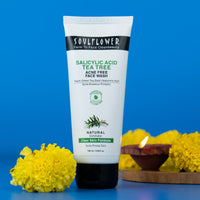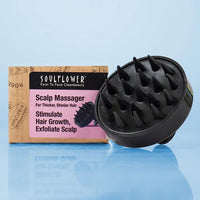Hair trims don’t exactly scream excitement. You sit in a chair, someone cuts a few inches, and you go home thinking your hair looks the same. But ask anyone who’s been on a proper hair growth journey, the real glow-up starts when you stop fearing scissors.
Now comes the burning question: do trims help hair grow? The short answer is no. But if you're here for real hair goals, the full story is way more interesting.
So, let's talk about trims, hair growth, and how the secret to Rapunzel-level hair might actually be in your next salon appointment, paired with a bottle of Soulflower Rosemary Lavender Hair Oil.
Hair Growth: It’s a Scalp Thing, Not a Scissor Trick
Your hair doesn’t grow from the ends. That’s just dead protein. Real growth happens at the scalp, inside hair follicles. And that growth depends on three things:
- How healthy your scalp is
- How well your hair is being nourished
- How long your hair stays strong before breaking.
Here’s the twist: even if your hair grows super fast, if it keeps breaking at the ends, you’ll never see the length.
That’s why trimming isn’t just about tidying up. It’s a key part of your hair care routine for growth.
Why Trimming Can Actually Help You Grow Longer Hair
Alright, let’s clear this up once and for all.
Does cutting hair make it grow faster? Not biologically. But in real life, it sort of does.
When you trim your hair regularly, you're doing three important things:
- Preventing split ends and hair breakage
- Avoiding thin, straggly lengths
- Giving your hair a healthy foundation to grow stronger
It’s like watering plants. You don’t just water the roots and ignore the dry leaves. You remove the bad parts so the whole thing can thrive.
Split Ends - The Villains of Every Hair Story
Split ends look tiny, but they cause maximum damage.
If you’ve been growing your hair for months and it still looks the same length, the real problem could be sitting at your ends. Split ends don’t just stay split. They move upward, damaging the hair shaft and causing breakage from mid-length.
So, you oil your hair, you shampoo, you use conditioner... but your ends? They’re literally tearing themselves apart.
That’s why regular trimming isn't about losing length. It’s about saving length.
How Often Should You Trim for Hair Growth?
There’s no one-size-fits-all answer. But here’s a lifestyle-friendly guide:
- If your hair is chemically treated: every 6 to 8 weeks
- If you heat-style often: every 8 weeks
- If you’re on a hair growth mission: every 10 to 12 weeks
- If your ends feel like straw: book that appointment yesterday
And for those who oil their hair weekly with something nourishing like Soulflower’s Rosemary Mint Hair Oil, you’ll need fewer trims , because your strands are already getting protected and hydrated.
Signs You’re Seriously Overdue for a Trim
Not sure whether you need a trim? Here's your reality check:
- Your hair tangles like fairy lights in a drawer
- The ends look lighter, thinner, and feel rough
- You need two pumps of serum to manage frizz
- You keep googling "why my hair looks unhealthy"
- Your hair looks flat even though you swear you haven’t layered it
If this sounds like you, take it as a sign from the hair gods.
Hair Trims vs Haircuts - Learn the Lingo
Let’s not confuse a haircut with a trim.
A haircut changes your style. Layers, fringes, bobs, it’s a look.
A trim, on the other hand, is maintenance. You’re removing about half an inch to an inch just to keep the ends fresh. You can trim your hair and still keep your long-hair fantasy alive.
Pro tip: Always ask your stylist for a “dusting” if you fear losing length.
Hair Growth Isn’t Just About Trims: It’s a Whole Lifestyle

Want your trims to actually help you grow long, lush hair? You need to build the full routine.
Here’s how:
1. Oil Smartly, Not Just Regularly
Go for oils that actually stimulate blood circulation, reduce hair fall, and strengthen strands. Try Soulflower Rosemary Lavender Hair Oil , it’s clinically proven to grow 42,000 new hairs in 90 days.
2. Protect Your Hair While Sleeping
Use a satin pillowcase or braid your hair loosely. Less friction = fewer breakages.
3. Avoid Over-Washing
Washing your hair every day dries it out. Stick to 2–3 times a week and use a gentle, sulphate-free shampoo.
4. Trim Strategically
Time your trims right after major seasonal changes or before festive styling seasons. Think pre-Diwali or before wedding invites pile up.
Myths You Need to Forget Today
Let’s debunk some myths that still float around:
- I’ll lose all my growth if I trim: Nope. You’re only cutting off damage, not progress.
- Trimming ruins curly hair: Curly hair needs trims even more, especially to avoid fairy knots and split curls.
- I don’t need trims if I use oils: Oils nourish, but they don’t magically stitch split ends back together.
Your Trimming + Soulflower Combo: Hair Care That Works
Okay, now that you know trimming is crucial, let’s pair it with the best oils to maximise growth:
Packed with fatty acids and Vitamin E. Perfect for hairline growth, postpartum hair loss, or just stubborn areas.
Soulflower Rosemary Lavender Hair Oil
This one’s the superstar. Rich in rosemary and lavender, it soothes the scalp and boosts regrowth.
Soulflower Rosemary Mint Hair Oil
A lightweight option that’s great for humid Indian summers. It smells divine, strengthens ends, and controls frizz.
All are cold-pressed, 100% vegan, and chemical-free, because your scalp deserves clean care.
How to Make the Most of Trims
Here’s your simple action plan:
- Trim every 10–12 weeks
- Apply a Soulflower oil at least twice a week
- Focus on massaging your scalp for 5 minutes
- Don’t overheat or overwash your hair
- Protect the ends while styling
With this approach, you’re not just growing hair. You’re growing healthy, strong, and camera-ready hair.
Takeaway - Let Your Hair Grow, But Make It Smart
So, what have we learned?
- No, trimming doesn’t push hair out of your scalp.
- But yes, trimming is essential if you actually want to see your hair grow longer.
- Pairing regular trims with nourishing, growth-boosting oils like Soulflower’s Lavender or Mint blends will make a visible difference in 90 days.
Skip the scissors for too long, and you’re setting your hair growth back. But trim regularly, oil mindfully, and maintain your routine, you’ll be surprised how fast your hair levels up.
Hair Health Starts With Soulflower
Want to begin your trimming routine the right way?
Grab the Rosemary Lavender Hair Oil for thick regrowth, or the Mint Cooling Hair Oil for a lighter, everyday hair vibe.
Or go full-on power mode with the Organic Castor Oil, it’s grandma’s remedy, but smarter and cleaner.
Because trimming is only half the job. The real magic? That’s in the bottle.
Frequently Asked Questions
Q1: Do regular trims help hair grow faster?
A: Not directly, but trims prevent split ends and breakage so your hair can grow longer without damage.
Q2: How often should you trim your hair for growth?
A: Every 10 to 12 weeks works best to maintain healthy ends and keep your growth journey smooth.
Q3: What are the signs I need a hair trim?
A: If your ends feel rough, tangle easily, or look thin and frizzy, it’s time for a quick snip.
Q4: Can split ends affect hair growth?
A: Yes, split ends can travel up the strand and cause breakage, making it harder to retain length.
Q5: Will trimming my hair make it thicker?
A: Trimming won’t change your hair texture, but it removes thin, damaged ends and gives a fuller look.










